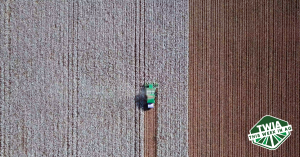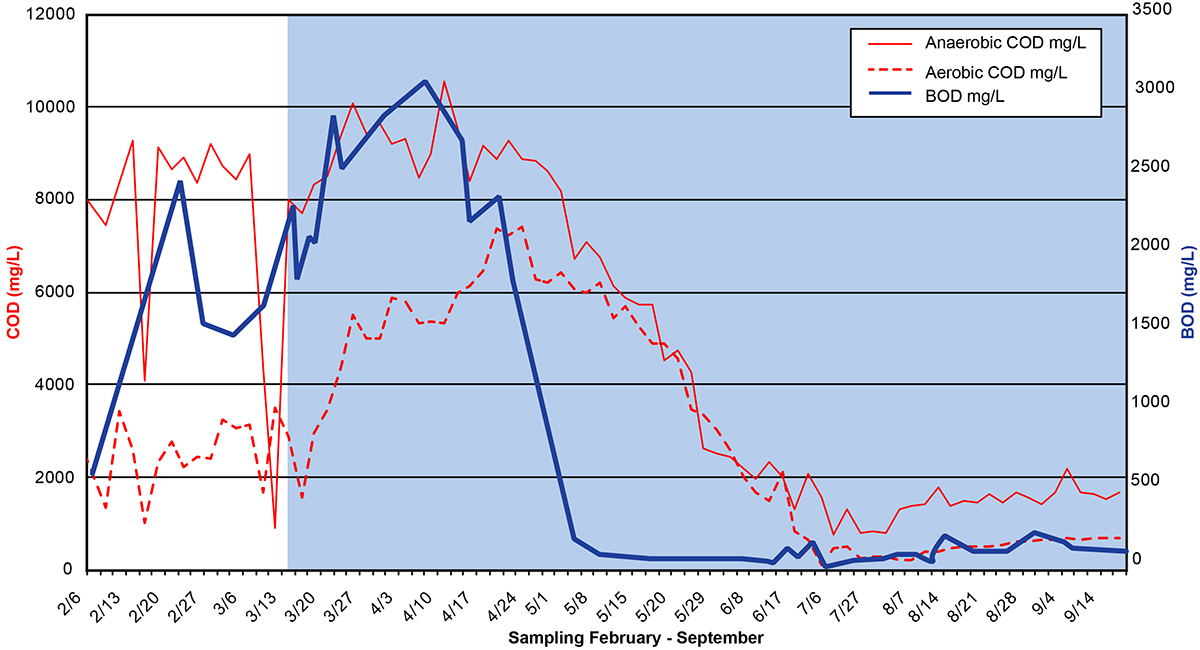Within a few months of operation, a lagoon and spray field system at a corn processing plant in Indiana began giving off offensive odors. Chemical oxygen demand (COD) levels in the anaerobic and aerobic lagoons climbed to 8,000 mg/L and 4,000 mg/L respectively. The pH in the anaerobic lagoon was dropping dangerously low for methane production. Attempts to resolve the issues with bacteria, odor masking products, and lime were unsuccessful and short-term at best. Lime settled to the bottom of the lagoons, temporarily raising pH and reducing odors. The odor soon became unmanageable and an annoyance to neighbors.
In March, Probiotic Solutions® BIO ENERGIZER® was administered to the anaerobic lagoon at the rate of 1 gpd. Within 4 weeks of initial application, pH began rising and the odors were dramatically reduced.
BIO ENERGIZER® applied over a period of 30 days to the anaerobic lagoon system of the corn processing wastewater treatment plant resulted in biochemical oxygen demand (BOD) and COD reduction, odor reduction, and improved pH levels. COD levels in surplus effluent that was pumped to the city dropped from 8,000 mg/L to 200 mg/L, saving the plant $22,000 per month in excess COD charges.
Product Information
Probiotic Solutions® BIO ENERGIZER® is a formulation of nutrients, organic acids, natural biological stimulants, and energy systems that balance the natural microbial ecosystem to increase bio-oxidation capacity in lagoon systems. BIO ENERGIZER® is a broad-spectrum bio-activator containing over 30 essential microbial growth-promoting ingredients.
Related Posts

Chemical Dosing for Phosphorus Removal
By Jared Alder, MS There has been a big focus in domestic wastewater on the removal of phosphorus and the potential for excess phosphorus to cause eutrophication in receiving water. Treatment facilities of all different shapes and sizes with inadequate phosphorus treatment technologies have the potential for excess phosphorus release. The removal of phosphorus from

This Week in Ag #86
Yesterday was #WorldCottonDay. That’s a fitting title, considering how creating the world’s most popular fabric is truly a world endeavor. Cotton is a crop mostly grown in Asia and the Americas, whose end products are mostly designed in Europe and mostly manufactured in Asia, and largely consumed in the world’s wealthiest countries (the USA accounts

Pickin’ Time or Payout Time? The Reality of Fall Harvest
Fall is usually the most exciting season on the farm, but this year rising input costs and declining farmer sentiment are overshadowing the joy of harvest. With corn facing steep losses per acre and overall farm expenses projected to hit record highs, the numbers tell a sobering story for agriculture’s most important season.


